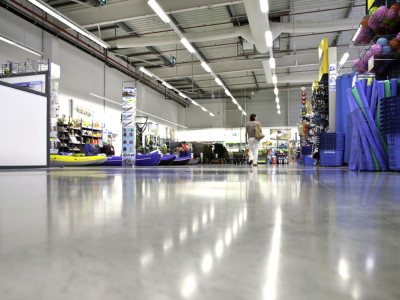Will using a dry-shake topping affect the slip resistance of concrete floors?
When creating an industrial or retail concrete floor surface, it is important to balance all the needs of the building and its users.
Coloured concrete, achieved using a dry-shake topping (which can also be applied as a wet-on-wet slurry), is popular in order to give the floor a protective and distinctive finish.
The power trowelling process, which blends the dry-shake with the surface water in the concrete, gives the floor gives a smooth finish – useful to ensure MHE can travel smoothly and efficiently over the surface.
But will a smooth finish reduce the slip resistance of the concrete floor? If humans need to walk across the floor, will they be at risk of slipping should the floor become wet? Balancing both requirements is vital, to ensure efficient operations and health and safety.
Regulatory requirements
The Workplace (Health, Safety and Welfare) Regulations 1992 require floors to be suitable, in good condition and free from obstructions, so that people can move around safely.
The UK Health and Safety Executive (HSE), in their technical information sheet, recognises that it is more than the floor’s surface materials alone which contribute to safety. Factors including cleaning, contamination, footwear, behaviour, use and the environment all play a part.
Method of test for concrete floor slip resistance
However, it is still possible to measure concrete floor slip resistance; and to do so the HSE recognises a method of test called the ‘pendulum test’, which can be undertaken on-site or under laboratory conditions.
An imitation heel is swung over a floor’s surface, the resistance is measured, and a Pendulum Test Value (PTV) is derived.
A value of 0-24 means there is a high slip potential; 25-35 is a moderate slip potential; and 36 or more is regarded as a low slip potential.
To measure slip resistance in wet conditions the HSE also recognises a surface microroughness test, which can be used in conjunction with the pendulum test.
Slip resistance results for Rocland’s surface hardeners
Rocland’s Qualitop surface hardener has been tested using the pendulum test, and the results clearly showed the surface presented a low slip potential.
A PTV of 56 was obtained – in wet conditions – which is a very impressive result.
The test result was the same regardless of whether the surface hardener was applied as a dry-shake topping or as a ‘wet-on-wet’ slurry.
Our recommendations
Our Qualitop surface hardener was developed for heavy-duty applications, including engineering, and for years has been widely used in retail warehouses (where the likelihood of slipping may be higher). It’s important to remember though that correct finishing of the concrete floor is vital for good slip resistance.
Where conditions will usually be dry, it will be quite sufficient to use Qualitop and simply power-float the concrete surface during the floor’s construction. It is always best to keep the concrete floor’s surface clean and dry, to ensure good performance and reduce the chances of slipping.
If it is likely that the concrete floor may become wet it can help to add a texture to the floor, to slightly increase the floor’s roughness. This can either be done by normal wear (although this takes time); or by artificial texturing (eg, acid etching or light shot/grit blasting). This is often an effective way to ensure that MHE and people can both use the floor more safely.
These recommendations are, of course, just a general guide. Our technical staff will be happy to give you more specific advice for your application to ensure you choose the best Rocland surface hardener which correctly balances all the requirements for your floor.




